
Roche and partner Klinrisk have picked up a CE-mark in the EU for an AI-based tool that can be used to predict renal function decline in patients with chronic kidney disease (CKD).
The algorithm will be added to Roche’s navify library of clinical decision-making algorithms and other digital health technologies (DHTs), designed to assist healthcare systems in delivering faster and more tailored treatment for patients, which was launched a couple of years ago.
Now, navify spans dozens of digital health algorithms covering applications in oncology, cardiology, and other disciplines like respiratory and infectious diseases, and serves as a marketplace that allows clinicians to easily order the medical algorithms they need from Roche, as well as other DHT providers.
Roche and Klinrisk said that the Kidney Klinrisk Algorithm is the first AI-based risk stratification tool to assess progressive decline in kidney function to get a CE-mark.
The algorithm is for early risk assessment of adults diagnosed with CKD and those with diabetes or hypertension at elevated risk for kidney function decline, and complements the already CE-marked Kidney KFRE Algorithm, which is used to manage later disease stages of CKD.
Identifying patients at risk of progression could allow for earlier use of medicines that have been shown to slow down CKD, including SGLT2 inhibitors and Novo Nordisk’s GLP-1 agonist Ozempic (semaglutide), before too much kidney function is lost.
The launch of navify underlines how pharma companies are extending the use of AI beyond drug discovery and development to include tools that can assist in the conduct of clinical trials and support personalised treatments for patients.
Matt Sause, who heads up Roche’s diagnostics business, said that the launch of the Kidney Klinrisk Algorithm, “as part of our chronic kidney disease algorithm panel, represents a significant advancement in the fight against this often silent, progressive disease.”
Sometimes referred to as a ‘silent killer’, CKD affects between 8% and 16% of the global population – upwards of 700 million people – and often goes undiagnosed for some time, so improved detection and monitoring tools are desperately needed. It is expected to become the fifth leading cause of mortality globally by 2040.
In a study of the Klinrisk model reported in 2023, based on data from a diverse population of over 4 million US adults, it was found to be more than 80% accurate in predicting CKD progression over a five-year period.
With early diagnosis and appropriate treatment, it is possible to delay or prevent kidney function decline, and reduce cardiovascular risk and related healthcare costs.
The CKD panel is now available in the EU and the UK, with later launches planned for the US, the Middle East, and Asian markets.










